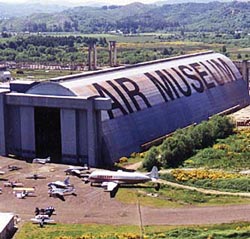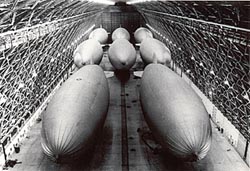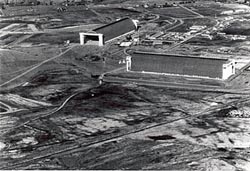
The U.S. Naval Air Station Dirigible Hangar B is associated with important post-World War II military patrols of America's West coast. Plans for building an airport at Tillamook, Oregon, took shape during the summer of 1941 and by September the placement of the airport south of the town had been decided. When the United States entered World War II after the Japanese attack on Pearl Harbor in December 1941, the Navy launched its full non-rigid airship program, which resulted in a series of hangars built in 10 different locations throughout the United States. These hangars mark a significant period of aviation history when airships were an important part of the U.S. anti-submarine defense. All, including the Lighter-than-Airship Hangars in Tustin, California, were built using the same plans and construction began during the early years of World War II. The Tillamook valley was a naturally protected site between San Francisco and the Straits of San Juan de Fuca which made it an ideal base for patrol of this coastal region. Work began on the "Lighter-than-Air" station immediately with the clearing of 2000 acres of dairy farm land four miles south of the city of Tillamook and six miles inland. This area at the southern end of Tillamook Bay was composed of old gravel bars, filled-in riverbeds and sedimentation. It required over two million cubic yards of gravel for grading. The Administration Buildings went up first and were soon followed by barracks, mess halls and roads. Railroad connections to Tillamook and the airport were finished along with the gatehouse and fence by September 1942.

The two hangars built at Tillamook were designed for the "K" style blimps. Hangar "A" was built at a cost of $2,405,395.00 and Hangar "B" for $3, 110.048.00. They both have an egg-shaped roof shell. Stiffened with a series of 51 transverse arch ribs, each building is 1050 feet long, 296 feet wide and 175 feet high. The dimensions of the hangars were so huge that there was no precedent for the manner of their construction. Hangar "B" was started in October 1942 and finally finished on August 15, 1943. Hangar "A" was started on July 26, 1943 and finished except for the final roofing on August 27, 1943, in just 27 working days--avoiding the costly delays and bad weather that affected the construction of Hangar "B." By reason of dimensional magnitude and the volume of lumber used, they are among the largest buildings in the world framed of timber. Two interior catwalks run the length of each hangar, one at each side at a height of 137 feet above the ground. Stairways at each end of the hangar lead from the ground to the catwalks and thence to the roof. A middle stairway leads only to the catwalks. A monitor runs the full length of the ridge of the building. At each end of the hangars there are two pillars which have pockets to house the six huge doors when they are open (three in each pillar). Today, only Hangar "B" remains as Hangar "A" was destroyed by fire in 1992.

Eight "K" series airships (blimps) were housed at the Tillamook Naval Air Station. The "K" series blimps carried a crew numbering eight to 10 and were used for extended flight operations in the coastal patrols. The ships were 215.7 feet long, 79 feet high and 62.5 feet wide. They were armed with four depth chargers and two 50-caliber machine guns, mounted in the extreme forward upper section of the car. The techniques for air-sea rescue were developed at Tillamook Naval Air Station. Squadrons of FM-2's used the Naval Air Station Tillamook (NAST) as a refueling and rearming facility. In 1948 the Navy decided to close the Station at which time the County negotiated a lease with the Navy and a Commission was appointed to operate the Airport. In 1963, that Commission formally aquired the hangars and after the loss of Hangar A, the remaining hangar was established as a museum in 1994.
Visit the National Park Service Travel American Aviation to learn more about Aviation related Historic Sites.
Last updated: May 23, 2017
